“It’s worse than we could have ever imagined”, artist Peggy Lynn remarked on Friday night at the re-opening of the 1980 “The Real Estate Show.” Lynn, an original participant in “The Real Estate Show” has lived for many years in England, so the changes to the Lower East Side seemed to have come as a bit of a shock. Then, the neighborhood was broken down and filled with drug dealers and thug landlords; now it’s an upscale corporate development. This is worse.
But whatever you think of the changes to the Lower East Side, things have more or less come full circle since the 1980 “Real Estate Show”, in which Colab and various neighborhood artists broke into a locked building at 125 Delancey Street to protest the city’s policy of sustained neglect. (Full story here). That site on 125 Delancey Street will soon become one of the several SPURA/Essex Crossing mega developments.
This is not to say New York counterculture is gone; at the opening, I met Lädy Millard, who’s currently kickstarting “Under One Roof”, a project to convert a Bronx house into a public art space. Artist Jane Dickson also noted that her son had grown up around the “Real Estate Show” generation and now runs the space Silent Barn, in Bushwick.
Many attendees reported having mixed feelings about the developments, since they’ll contain condos, but they will also hold the highest addition of new affordable housing units in years. The extra real estate could help alleviate those rent hikes and maybe even start a new era of integration and stability which artists want so badly– but given the trends, that seems like a longshot. I asked a bunch of artists at the opening what they thought about that.
Jack Waters and Peter Cramer, Allied Productions co-founders and stewards of the ABC No Rio art collection. They helped to provide organizers with several of the works in the show (the rest came from individual artist collections).
Why do you think now is a good time to restage the show?
Jack Waters: Well…when we came to Colab, there was a lot of the talk about this 25-year [urban development] plan, this long-term plan that the city had in collusion with private corporate about turning over this Delancey Street strip.
The SPURA-Essex project?
Jack Waters: SPURA is what it’s become.
So [the city] has been talking about this since the eighties?
Jack Waters and Peter Cramer: Yes.
Peter Cramer: Yeah, that’s why they originally tore down the apartments. [Back in the eighties], there were tenement apartments between Grand and Delancey that were torn down in anticipation of a development that never came.
Jack Waters: It’s a no-brainer. This is the gateway into the city. In the older days, they moved all the poor people from the Upper West Side, from Midtown, to build Lincoln Center. That was what became the projects. And this became the poor area. And then at the end of the sixties, just at the end of the peak of white flight, this became an area for– the phrase used to be “regentrification”. And then they dropped the “re”, because it’s a cycle. So now we’re at another point in the cycle.
…The area had been very lively back in its day, back in the twenties. If you listen to Ella Fitzgerald, one of her lyrics is “It’s very fancy on old Delancey”. Or “Helly, Dolly”. This was like the uptown of the old days. So that’s why we’re here. We’re now at this point in the cycle.
So was it hard to get all of these works back after all these years?
Peter Cramer: Not really, it was taken care of since we came to No Rio in ‘83.
So is this all part of the official No Rio collection?
Peter Cramer: No, there are some pieces– Ilona Granet’s on the wall, Peter Fend’s photo piece of the Lower East side, Robert Cuni’s knife painting, the Latin brothers [artist unknown]…Cara Perlman…
Jack Waters: I think the core of it [is from the ABC No Rio collection]…Over the years, we’ve shown an amazing, representative part of it, but Becky came and she asked “do you have any of the original pieces?” And we said “We don’t know,” because we weren’t at the original “Real Estate Show”. So we started opening boxes, and these just kind of popped out. This Cara Perlman painting [title TK] is an especially interesting find. Peter knew of it, but we didn’t have it documented or catalogued. We always thought it was Alan Moore’s. We knew it, but we had misattributed it. So, Becky, being one of the original artists, was the perfect person to start identifying. We definitely provided the core of the archival work.
So [before 1983], much of this was this literally in boxes in the basement of ABC No Rio?
Jack Waters: At one time, yes. When we came to No Rio, it wasn’t even in boxes…it was in stacks…
Peter Cramer: It was just on flat constructed shelves that they had put in the basement…

Pile of cigarettes by Robert Goldman (Bobby G); Reconstructed Roommate Wanted sign by Matthew Geller (Image courtesy of Christian Grattan)
Is the stack of cigarette boxes [by Bobby G] all original?
Peter Cramer: [Laughs] No, that’s a reconstruction. The original pile was at least five feet by five feet and maybe four feet tall. There’s video tape of kids jumping into it and playing at the opening.
Robin Winters, an artist and SVA professor with work in “The Real Estate Show”
Robin Winters: I don’t know if it is a good time to restage it. It’s sort of the Disney-fication of the art world, that we’re now memorabilia, so it’s kind of like relics from old dinosaurs. But at the same time, if I talk to my students, they’re spending $700 a month in Bushwick to share a railroad flat. I live in a grandfathered-in Soho loft that I pay very little money in.
You gotta tell me how much.
Robin Winters: No. But very little. It started at 90 a month, and it’s gone up since then, but not that much. A little more than that.
Is that through the Loft Law?
Robin Winters: Yeah. And thank God for the Loft Law! I know a lot of people who moved into places there, and they just didn’t want to fight, they thought their landlord was nice, and they got screwed.
Becky Howland, one of the principal organizers of the Real Estate Show, co-founder of ABC No Rio, and a key organizer of the show (Archeologist)
Do you think now is a good time to re-stage the show?
Becky Howland: From the point of view of the external world, it couldn’t be a better time. With real estate, housing issues, being relocated, pushed around– that’s such a part of life in New York, I’ve found. And spreading out into the other boroughs.
Interrupted by John Halpern, who sticks his head in and asks “Are we starting a new petition?”
Becky Howland: You can, you go ahead! (Laughs)
So I think it’s really timely as far as that goes. Also the Essex Crossing project– we started talking about the show, and then they announced that that was supposed to be built. We didn’t know about that when we started talking about the show.
Anyway, In 2011, Max Schumann organized “A Show about Colab” at Printed Matter, and in 2012, Hunter College held “The Times Square Show Revisited”. So a lot of us are looking through our archives. It’s that 30-year period, where it seems those are the art history cycles. And it seems to me, you’re either going to be remembered or your work’s going to be in a dumpster. So I’m happy that it looks like people are relating to our work.
A week later, we continued the interview over e-mail.
Becky: Since James Fuentes moved his gallery to Delancey St, a few blocks away from the original show, he had the vision to present a show about “The Real Estate Show” – to construct the narrative arc separate from the story of ABC No Rio.
I shared James’ vision. For me, the Real Estate Show was “Exhibito Interruptus”. That is, the city shut it down before we’d barely had the chance to see it ourselves.
In order to show what we did, and how we did it, it made sense to me to locate as much of the original work as possible. That involved threading my way into the storage spaces of the ABC No Rio Collection, –where no woman had gone before! – and the ABC No Rio Archives.
So I became an archeologist. The nature of “The Real Estate Show” – mysterious and radical – meant that finding the artists and original artwork was sort of like…following the trail of a demented Hansel and Gretel. ( I guess that would be me and Alan at the time.) I went to Jack and Peter’s storage space in the East Village 4 or 5 times, and also to Alan Moore’s storage spaces in Staten Island. Steven Englander, the director of ABC No Rio, helped guide me through the archives there.
As I found more and more artwork, it felt fresh and new. I made a good faith effort to find as many of the artists as possible, and cajoled them into either finding their old work, or reconstructing it.
I hope that no one will ever have to go through what I did to discover the basic facts about the show!
I wasn’t planning on doing it. I did it simply because I was there at the show, I knew the artists and artworks, and I reviewed the existing documentation. As a child I enjoyed jigsaw puzzles. This had some of the same feel.
It was a tremendous learning experience, to build bridges between the various factions of the Collection, archives, and artists. In all instances, James and I worked to preserve the integrity of the original show – to demonstrate to younger artists what we did and how we did it – to inspire them with the fact that artists have agency that can be utilized for the common good.
For me, artists are the heart of the city. If artists can’t afford to live here, then New York bye-bye.
I wonder how many artists cannot meet the current minimum annual requirements for affordable housing. Probably a lot.
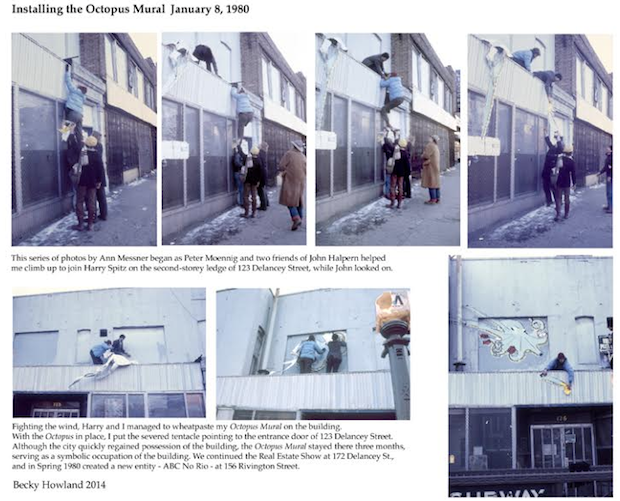
January 8th, 1980 installation of the Octopus Mural, one week after “The Real Estate Show” was shut down by the police (Image courtesy of Becky Howland)
Howland also created the Octopus Mural, which has largely been pieced together from fragments on the back wall of James Fuentes Gallery, and has become a sort of icon for the show. The original mural hung on the outside of 123 Delancey for three months after “The Real Estate Show” was taken down, as a reminder of the occupation. According to Howland, “The fragments exist because my friend Ulli Rimkus (Max Fish) kept an eye out for the mural and called me one day to alert me that it was starting to unpeel from the building.”
Jane Dickson, artist, longtime NYC resident, and original contributor to “The Real Estate Show”
Jane Dickson: [During the 80s], there was a huge pool of young artists that are doing temporary things to make a statement, and if it didn’t sell, they trash it. We were in this post-industrial world, where people were making do, making art out of scraps.
I think this group was a catalyst, and groups like Group Material said we want to do something like that, but let’s make it a little more controlled.
….We lived in Times Square for almost twenty years, while demolition was pending for the Times Square redevelopment plan. Eventually they did evict us and tear it down, and now it’s a luxury hotel. I don’t pine for the really skanky days when it was child molesters, hustlers, drug addicts– I mean, when it was primarily those people, I think it’s still all of that…But it’s just kind of pathetic that New York City, now, is just princes and princesses.
Ann Messner, an artist and key player in “The Real Estate Show”. At James Fuentes, she has printed a stack of posters of the original “Real Estate Show” manifesto
Has anybody considered writing a new manifesto?
Ann Messner: Well, what I think is interesting is that the manifesto is still operable today. That’s why I printed it, because I actually think, well what if that is the proposal today? To me, it’s a provocation. Some of the language is very 1980s, expressing solidarity with the “Third World”– but I think now especially considering the market forces, the relationship between artists and real estate and galleries, and the intensity of that capital, which has only exponentially increased– I don’t think it’s a bad thing for artists to consider their position within that frame. Economically, both art and real estate are high-end products that people stand to get more from their investment. Around Park Slope, Brooklyn, the real estate has increased almost fifty percent. The return is more than stocks, so [you can make a fortune in] real estate and art, if you do it right…And artists are really viscerally in that mix, in terms of gentrification; they’re the canaries, and artists are the ones who produce the product. So I do think that it’s a provocation. On the other hand, maybe it’s a little utopian.
I don’t think it’s utopian to care, necessarily…
Ann Messner: Well…what is the show? The show is an opportunity to show in a gallery. The “Real Estate Show” was a provocation. This is not a provocation. So how do we feel about that?
Are any of the works for sale in there?
Ann Messner: Well, yeah, they’re for sale, it’s a gallery. That’s not to be critical, necessarily. James Fuentes grew up in the neighborhood, he cares about the neighborhood, this is where his family’s from. And he’s running a business. On the other hand, Gagosian has just set up a pop-up gallery right across the street. I think that we shouldn’t be blind to these types of forces. I think this show is fine, but let’s not really pretend that this doesn’t have complications.
Now, on the other hand, Cuchifritos– that’s the project space for 2014, that’s actually meant as the provocation space. And it’s in the market that’s going to be torn down. So you know Cuchifritos is nonprofit, it has a history of working in the neighborhood, in the market, and it will be torn down. So in a way, there is a sort of kinship between 125 Delancey Street the building of the original real estate Show, and the Essex Street Market. So that’s my opinion.

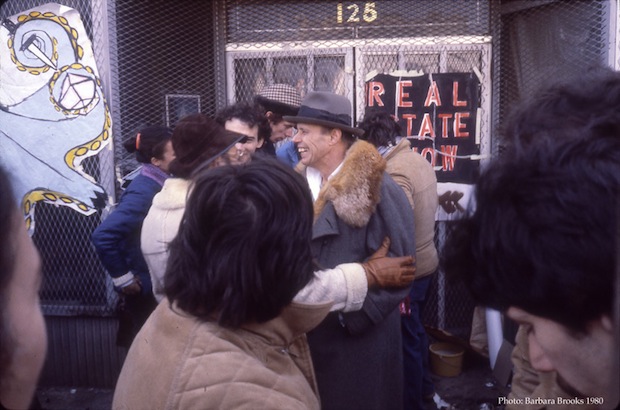
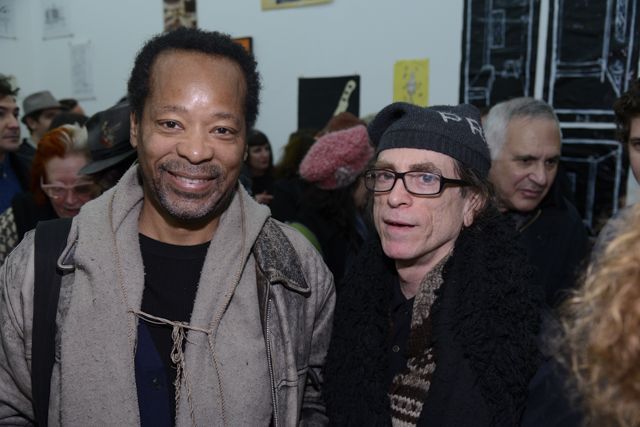

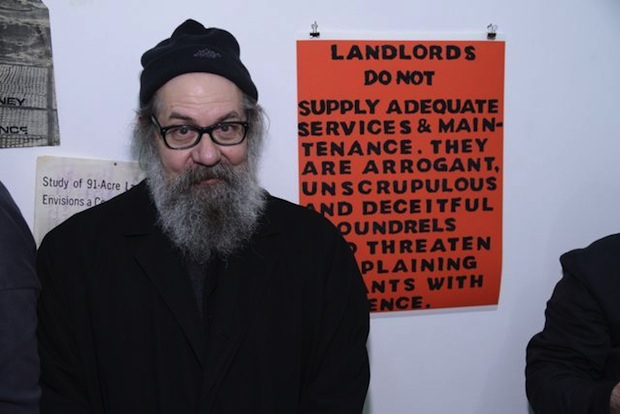

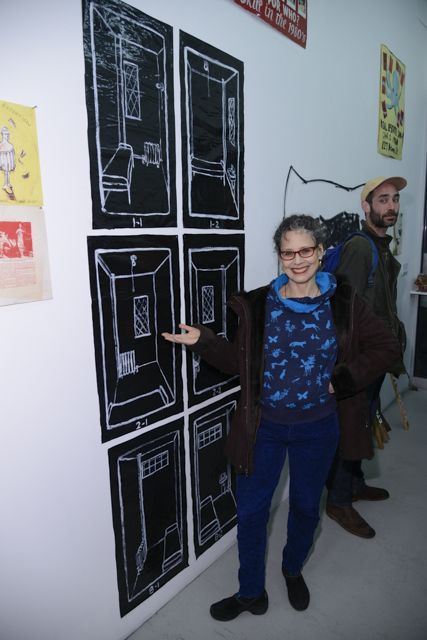
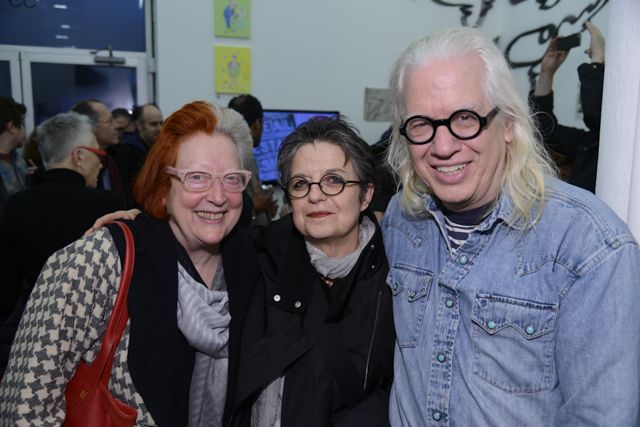
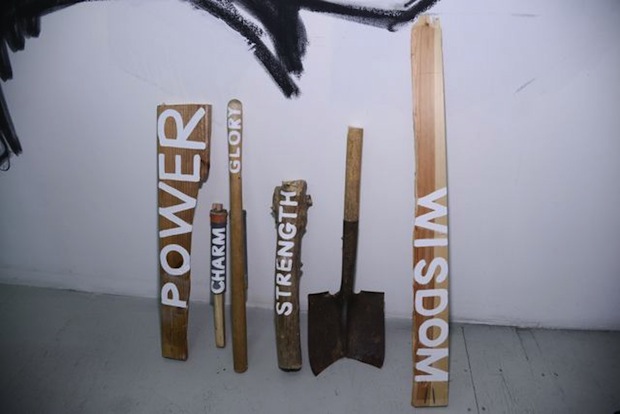

Comments on this entry are closed.